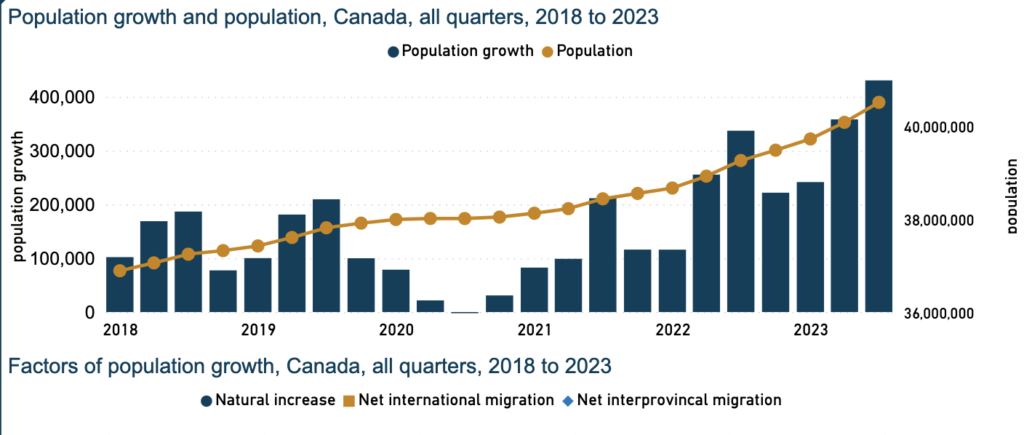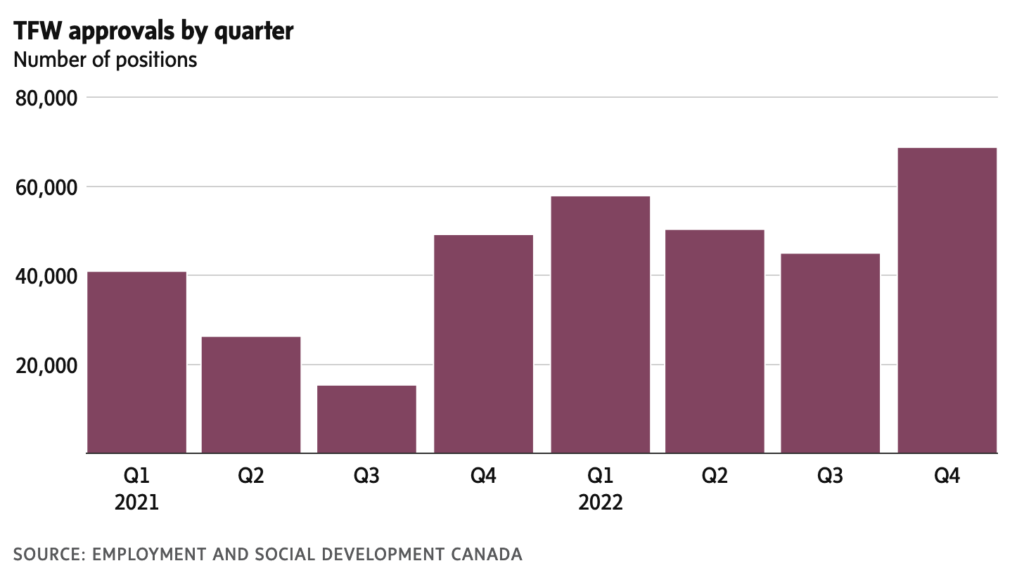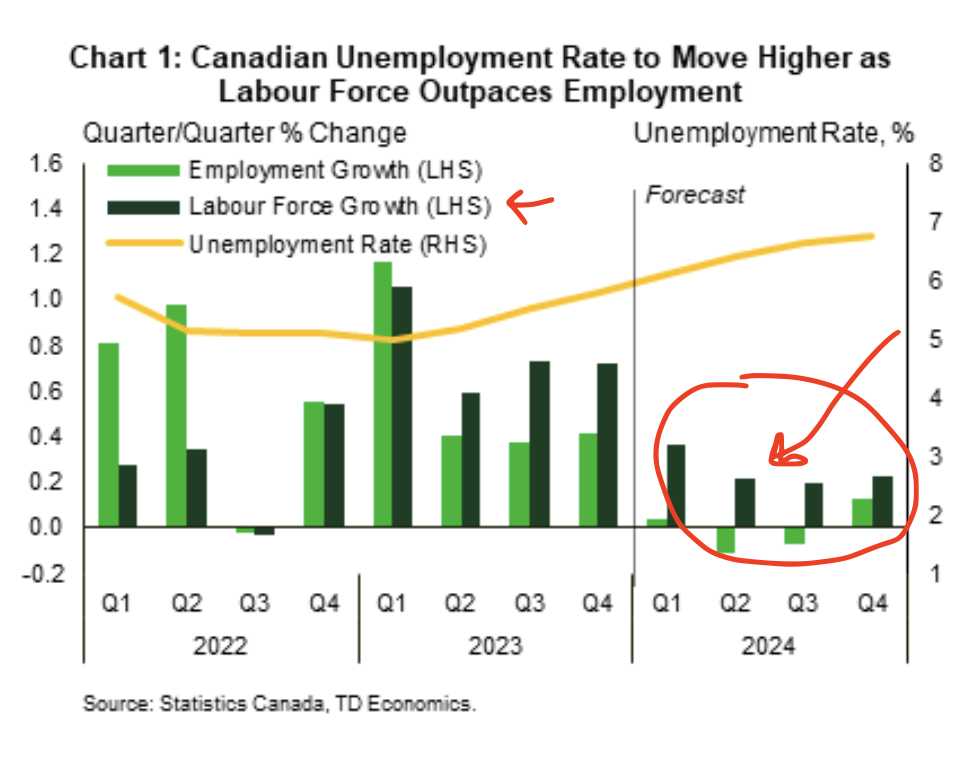
Lately, you may have noticed a shift in the workforce demographic while picking up your local Timmies order.
You may also realize that survival jobs are getting harder to get, and people just can’t find a job in Canada as quickly as they used to.
In fact, we could go as far as to say landing a job in today’s economy is much tougher than it was just a few years back. It also probably pays much less.
The root cause? It circles back to Canada’s unregulated immigration loopholes and how they’re manipulated by both domestic and international entities looking for easy access into the Canadian labour market.
Ultimately, Canada’s immigration system has holes in it that are allowing working age people into the country at a record pace with little oversight.
It leaves both long-time residents and newcomers struggling to find their footing in the Great White North.
In this report, I will unveil the key immigration programs contributing to the misuse of Canada’s immigration system and explain how they each play a role in why you can’t find a job in Canada these days.
Let’s delve into the details.
oh, and if you’d prefer to watch a video on this exact topic instead, check out or video version of this article below!
The 4 Culprits of Why You Can’t Find a Job In Canada
Canada’s population increased by 1.15 million from July 1, 2022, to June 30, 2023. Currently it’s 2024 and there’s no sign of the trend stopping.
Amongst the 1.15 million newcomers in the 2022/2023 period, International migration accounted for 98% of the population growth – pilling fuel on the fire of Canada’s cost of living, real estate, and healthcare crises.

So, how come… and how exactly did Canada let in 2.9% of its population in one year? For that we must look into Canada’s immigration system.
Well, it wasn’t intentional, but rather from multiple ways where you can easily get a permit to work and stay in Canada stemming from our unkempt immigration system.
Our analysis shows there are 4 main streams of entry that are used to circumvent Canada’s official immigration system, and feed into the massive glut of labour force participants.
These four streams are:
- The Temporary Foreign Worker Program (TFWP)
- International Mobility Program Umbrella (IMP)
- Post Graduate Work Program
- Study Permits
When we couple these programs with Canada’s lack of immigration enforcement and questionable border protection agency (CBSA), these entry points into the Canadian economy have become a massive open door to work in Canada without much oversight.
Next we will explore the impact each of these streams have on Canada’s labour market and how each one is exploited for quick access to Canada.
First, We Must Understanding the Temporary Foreign Worker Program (TFWP)
The Temporary Foreign Worker Program (TFWP), established by the Canadian federal government in 1973, was initially designed to support specific sectors of the economy and address labor shortages in areas where Canadian workers were scarce.
Originally, the TFWP focused on agricultural roles and live-in caregiving positions.
However, over the years, it has broadened its scope significantly.
Today, the program encompasses a wide range of occupations, from high-skilled positions like scientific researchers to more common roles such as cashiers at Tim Hortons.

The program’s inherently temporary and transient nature has often cast it in a controversial light, seen by some as a less-than-ideal solution for workforce needs in Canada.
This perception is compounded by many allegations of exploitation and mistreatment of foreign workers by their Canadian employers, raising questions about the program’s regulation and oversight.
The TPFW requires a positive or neutral economic impact labour assessment before one can hire via this program. The assessment is referred to as a Labour Market Impact Assessment (LMIA).
Employers can apply for one via an online portal and It costs $1000 for each position requested in your LMIA.
Although it sounds pricey, it’s become a way to bypass the steeper costs of hiring a full or part-time Canadian employee that comes with higher costs attached. Plus the Canadian workers aren’t as indentured to the employer as the TFW is.
Employer’s in Canada who’d like to hire a TFW can choose from a few different streams.
| TFW Streams |
| Primary Agricultural Temporary Foreign Worker |
| Caregiver |
| Academic Positions |
| High Wage Positions |
| Low Wage Positions |
How the TPFW is Exploited to Work in Canada:
So, how did the TPFW become one of the hottest ways to start working in Canada without going through the immigration system?
Its because recently, the TFW program has evolved outward from the agricultural sector and into, well, all other facets of the Canadian economy as employers look to employ low wage cashiers to high-cost programmers at a fraction of what a Canadian would cost. And boy has it been taking off:
Below, from 2021 to 2022 there’s been a net rise in approvals of TFW positions each quarter and on a yearly basis.

| 2019 | 73,360 |
| 2020 | 76,504 |
| 2021 | 82,495 |
| 2022 | 119,820 |
| 2023 | ~ 117,762 |
Sadly, the Temporary Foreign Worker Program (TFWP) in Canada, designed to fill gaps in the labor market, often becomes a ground for exploitation by both employers and foreign workers, particularly in the Low Wage Position stream.
Low Wage TFW Immigration Stream: The Gateway to Exploitation
Many individuals, eager for a new life in Canada’s prosperous landscape, are willing to accept any job opportunity. Employers capitalize on this desperation. They often obtain a Labour Market Impact Assessment (LMIA) under the pretext that no Canadian worker is available for roles, typically in low-wage sectors like fast food.
After securing a favorable LMIA, these employers collaborate with employment agencies, some of which specialize in sourcing Temporary Foreign Workers.
These agencies tap into international labor pools, marketing low-wage jobs in Canada as golden tickets for work and potential residency. However, what is often not disclosed is the reality that follows the completion of their term.
Many workers, having built lives in Canada, choose to stay beyond their permits, inadvertently adding to the competition in the low-skilled labor market and contributing to the reason why you can’t find a job in Canada.
High Wage Stream: A Different Shade of the Same Problem
A similar pattern of exploitation is evident in the High Wage stream of the TFWP. Here, employers engage skilled foreign workers through agencies, bypassing Canadian employees who would command higher wages.
This practice not only undermines the local labor market but also places the foreign workers in a vulnerable position, as they become dependent on their employers for their status in Canada. For many, the TFWP becomes a strategic alternative to navigate around the slow-paced official immigration system based on points.
Adding to this, on January 2023, spouses and dependants of workers who come under the International Mobility Program and those in higher skilled occupations coming under the Temporary Foreign Worker Program are eligible for open work permits as well opening the door for unbridled chain migration into Canada.
The Broader Impact of TFWs
Employers and foreign workers, driven by their respective needs and ambitions, find ways to maneuver through the loopholes of the TFWP.
This exploitation, however, opens large concerns about the fairness and integrity of the Canadian labour market and it’s immigration enforcement policies.
Furthermore, It’s easy to think that the increase in TFW’s can make people think they can’t find a job in Canada is due to themselves, however in the following section, we will delve deeper into these issues and uncover why it’s not.
The Second Entry Point: International Mobility Programs (IMP)
Canada’s International Mobility Program (IMP) is a blanket term for various separate streams or categories that could allow a foreign individual to get a work permit or an employer to hire a foreigner to work in Canada.
Hiring from this stream doesn’t require a Labor Market Impact Assessment from the employer nor does it make an employer have to even look for a Canadian suitable for employment first.
Canada’s International Mobility Programs are a series of immigration streams centred around supporting broader economic, social and cultural objectives in the country.
These streams underneath the IMP umbrella vary widely and not all of them are exploited for quick entry into the Canadian workforce.
IMP streams include:
- Workers covered by international trade or bilateral agreements
- Ex. Youth taking part in working holiday exchanges,
- Employees transferred within a multinational company
- Certain academic professions
- Charitable and religious workers
- Spouses or Common Law Partners of Skilled Workers
- Spouses of Students
- Post Graduate Work Program
Here’s What You Need to Know About PGWP:
So, let’s talk about the Post-Graduate Work Program (PGWP) in Canada. It’s meant to be a good work opportunity for international students who’ve just finished their studies at a Canadian college or university.
Basically after finishing their studies they can get the PGWP, that lets them work anywhere in Canada for as long as they studied. For example, if they did a two-year course in journalism at Fanshawe College, you can work for two years in Canada in any job on this permit.
You don’t need to have a job lined up to get a PGWP. This part is a bit of a problem because it means a lot more people are trying to find work, which can make the job market really crowded.
How the International Mobility Program Is Exploited to Work in Canada:
Sounds like a good deal, right? The IMP streams are supposed to get more students into Canadian schools and then let them help out the Canadian economy by working after graduation.
But here’s the catch: things have gotten a bit messy. Some well-known Canadian colleges and even some smaller schools that don’t have much of a reputation have been kind of bending the rules and marketing there courses internationally as a way into Canada’s economy without going through the normal immigration channels.
As you can see here, the IMP umbrella seems mundane. However, inside of it there lies a few angles where it’s being used to surpass the usual immigration channels in Canada.
These are the Postgraduate Work Program and the work permit eligibility for common law or marital spouses of skilled workers or students to apply and work in Canada.
The latter is where International Students and their spouses qualify to gain an Open Work Permit to work full time in Canada without getting a labour assessment done. Increasing labour force participants in many cases.

Furthermore students enrolled in an Designated Learning Institution (DLI) with a PGWP under the IMP umbrella can apply to get an open work permit after they graduate which is valid for the length of their program which they studied – making it quite the juicy option for those looking to make some Canadian cash before going back to their home country.
Of course, all of these students don’t always plan to stay in Canada, and many of them send billions of dollars in remittances back to their home country, so not only are Canadians and international students competing against each other, the money being made is not staying in Canada.
Canadian Study Permits: The Cheat Code to Entering the Canadian Labour Market
Let’s talk about Canadian Study Permits, the not-so-secret key to overwhelming Canada’s job market.
Once a tool to get a Western education, they’re now prime a gateway for shady immigration peddlers selling a fake Canadian dream.
We’re talking about exploitation at its finest, courtesy of Canada’s once-revered educational institutions and a bunch of diploma mills disguised as colleges.
The Study Permit: A Wolf in Sheep’s Clothing?
Getting a study permit is like playing a game where the rules are laughably easy. Accepted by a Canadian ‘school’? Check. Proof of funds (a hefty 20K+ in 2024)? Check. But here’s the kicker: the system is so easy to game it’s practically inviting fraud. A little Photo-shop magic, visit a diploma mill, practice your poker face, and voila – you’re in.
The Perks of the Canadian Study Permit
Oh, before I tell you how study permits are used to bypass the original Canadian immigration system, you should first understand the benefits that come with it:
- Part-Time Work? More Like Full-Time Hustle: Work 20 hours a week off campus – but who’s really keeping tabs?
- Campus Jobs Galore: Full-time work on campus? Sure, why not.
- Extra Time in Canada: The permit lasts for your whole study program, plus a bonus 90 days.
- Bring Your Squad: Your spouse or partner gets an open work permit too. Everyone’s working!
How Study Permits are Exploited to Work in Canada:
But here’s where it gets murky and here’s where it can get exploited as why briefly mentioned earlier.
In Canada, there’s been a surge of storefront colleges, aka diploma mills, which have popped up.
These ‘schools’ often in a shopping plaza are more about facilitating immigration than providing education.
These places are ghost towns, with empty classrooms and zero learning. It’s a money-making scheme: foreigners get a backdoor into Canada’s job market, and these fake colleges rake in cash from application fees. And boom, you and all the other immigrants that are coming here are left wondering why they can’t find a job in Canada.
Government Crackdown: The Last Straw
The situation got so out of hand that by January 2024, the Canadian government had to step in. They announced a cap on study permits, signaling a major red flag. It was a desperate move to curb the exploitation and abuse of a system that was once respected. This crackdown speaks volumes about how these permits became a villain in the tale of Canadian immigration, distorting the job market and undermining the integrity of the education system.
However, as much as they government would like to appear as it’s helping it’s citizens, these measures were more bread and circus for the pony show. Not only do they not tackle to root cause of the problem, but they don’t put a dent in the pent up job demand across Canada.
What’s The Big Deal? We are in a Labour Shortage, Right?
It’s a common perception, partly fuelled by anecdotal experiences like the temporary closure of a local Tim Hortons due to staffing issues, that Canada is facing a labour shortage. This belief is often reinforced by concerns over the aging population, particularly the retirement of baby boomers, coupled with the country’s low birth rates.
While these factors are indeed occurring, they do not fully account for the state of the Canadian labour market.
The Reality: An Oversupply of Labour In Canada
Contrary to the labour shortage narrative, the current challenge in Canada’s job market is not the lack of willing workers, but rather an over-saturation of the labour force in certain sectors. This situation is particularly evident in entry-level service roles and skilled positions. Employers are increasingly opting for individuals on Temporary Foreign Worker (TFW) programs or their spouses, who are often willing to work for lower wages, over more expensive Canadian labor.

Data supports this trend. As highlighted in one of our previous articles, an economic analysis from TD Bank revealed that the growth of the labour pool is significantly outpacing the availability of jobs.
Exploring Opportunities Beyond Canada: Finding Your Ideal Job Abroad
For many, the Canadian dream has become increasingly challenging due to complex immigration policies and governmental decisions. If this resonates with you, it might be time to broaden your horizons and consider opportunities outside of Canada. Numerous countries offer thriving job markets in diverse economic sectors, not solely dependent on housing markets or heavy immigration.
To assist you in identifying the best fit for your career aspirations and lifestyle, we have developed a comprehensive quiz. This tool evaluates 22 different parameters to suggest a country that aligns with your personal and professional preferences.
Looking to leave Canada?
Take the country quiz to see where you belong!

Leave a Reply